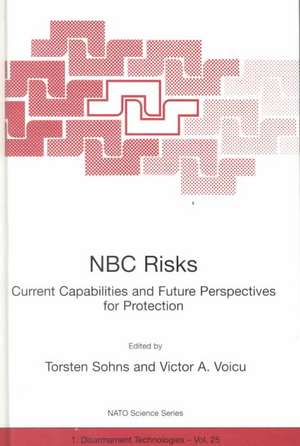NBC Risks Current Capabilities and Future Perspectives for Protection: NATO Science Partnership Subseries: 1, cartea 25
Editat de Torsten Sohns, Victor A. Voicuen Limba Engleză Hardback – 30 iun 1999
| Toate formatele și edițiile | Preț | Express |
|---|---|---|
| Paperback (1) | 2118.14 lei 6-8 săpt. | |
| SPRINGER NETHERLANDS – 30 iun 1999 | 2118.14 lei 6-8 săpt. | |
| Hardback (1) | 2125.27 lei 6-8 săpt. | |
| SPRINGER NETHERLANDS – 30 iun 1999 | 2125.27 lei 6-8 săpt. |
Din seria NATO Science Partnership Subseries: 1
- 15%
 Preț: 643.65 lei
Preț: 643.65 lei - 18%
 Preț: 949.23 lei
Preț: 949.23 lei - 18%
 Preț: 951.14 lei
Preț: 951.14 lei - 18%
 Preț: 950.96 lei
Preț: 950.96 lei - 18%
 Preț: 1226.42 lei
Preț: 1226.42 lei -
 Preț: 392.97 lei
Preț: 392.97 lei - 18%
 Preț: 944.36 lei
Preț: 944.36 lei - 18%
 Preț: 1227.04 lei
Preț: 1227.04 lei - 18%
 Preț: 1220.26 lei
Preț: 1220.26 lei - 18%
 Preț: 947.35 lei
Preț: 947.35 lei - 18%
 Preț: 952.09 lei
Preț: 952.09 lei - 18%
 Preț: 955.56 lei
Preț: 955.56 lei - 15%
 Preț: 643.65 lei
Preț: 643.65 lei - 18%
 Preț: 947.67 lei
Preț: 947.67 lei - 18%
 Preț: 1111.97 lei
Preț: 1111.97 lei - 18%
 Preț: 1230.66 lei
Preț: 1230.66 lei - 15%
 Preț: 650.86 lei
Preț: 650.86 lei - 18%
 Preț: 949.23 lei
Preț: 949.23 lei - 15%
 Preț: 640.37 lei
Preț: 640.37 lei - 15%
 Preț: 650.37 lei
Preț: 650.37 lei - 18%
 Preț: 1225.16 lei
Preț: 1225.16 lei -
 Preț: 391.40 lei
Preț: 391.40 lei - 18%
 Preț: 945.14 lei
Preț: 945.14 lei - 5%
 Preț: 1407.87 lei
Preț: 1407.87 lei -
 Preț: 398.15 lei
Preț: 398.15 lei -
 Preț: 390.46 lei
Preț: 390.46 lei
Preț: 2125.27 lei
Preț vechi: 2237.13 lei
-5% Nou
Puncte Express: 3188
Preț estimativ în valută:
406.67€ • 423.76$ • 336.72£
406.67€ • 423.76$ • 336.72£
Carte tipărită la comandă
Livrare economică 03-17 aprilie
Preluare comenzi: 021 569.72.76
Specificații
ISBN-13: 9780792358022
ISBN-10: 0792358023
Pagini: 543
Ilustrații: XIII, 543 p. 64 illus.
Dimensiuni: 155 x 235 x 30 mm
Greutate: 0.95 kg
Ediția:1999
Editura: SPRINGER NETHERLANDS
Colecția Springer
Seria NATO Science Partnership Subseries: 1
Locul publicării:Dordrecht, Netherlands
ISBN-10: 0792358023
Pagini: 543
Ilustrații: XIII, 543 p. 64 illus.
Dimensiuni: 155 x 235 x 30 mm
Greutate: 0.95 kg
Ediția:1999
Editura: SPRINGER NETHERLANDS
Colecția Springer
Seria NATO Science Partnership Subseries: 1
Locul publicării:Dordrecht, Netherlands
Public țintă
ResearchCuprins
I Nuclear, Biological and Chemical Risks — General Approach.- 1. The Proliferation of Weapons of Mass Destruction: Health Risks — An Analysis from a Medical Perspective.- 2. Intervention in a Chemical, Biological or Nuclear Disaster. A Romanian Point of View.- 3. Are the Civilians prepared for Chemical and/or Biological Warfare? The Need of a Cooperative Effort for a simple Guideline.- 4. Defense against Biological Terrorism — Scope and Limits.- 5. NBC Medical Planning System (NBCMedPlanS) — An Expert System.- 6. Planning of Medical Support for a Threatened or Actual Biological Environment. Principles, Policies and Procedures.- II Pharmacoprotection and Treatment.- 7. Finite Interactions Theory — A Biophysical Approach to Xenobiotic — Membrane Interface Interactions.- 8. A Theoretical Study of the Interactions of Acetylcholinesterase, Irreversible Inhibitors, and their Antidotes.- 9. Electrochemical Properties of Platelets: Clinical and Pharmacological Applications.- 10. Features of Apoptotic Cell Death in SCL II Cells after Exposure to 2,2-Dichlorodiethylsulfide.- 11. A NewView on the Mechanism of Action of Reversible Cholinesterase Inhibitors as Drugs for Prophylaxis.- 12. Cholinesterases as Bioscavengers for Protection against Organophosphate Chemical Warfare Agents.- 13. Selectivity and Protective Activity of Muscarinic Receptor’s Antagonists in Organophosphates Poisoning.- 14. Reactivators, from Classic to a New Generation.- 15. Convulsions in Organophosphate Intoxications: Their Mechanism and Treatment.- 16. Treatment of Organophosphate Nerve Agents, Current Therapy and Future Prospectives.- 17. Reactivation of Organophosphorus — Inhibited Human Erythrocyte-Acetylcholinesterase by Oximes in vitro.- 18. Cholinesterase Status in OrganophosphatePoisoned Patients.- 19. Testing the Antidotal Efficiency in the Treatment of Aflatoxin Poisoning.- 20. Zeolites as (Potential) Decorporating Agents.- III Skin Protection and Decontamination.- 21. New Concepts of Prophylaxis and Decontamination of Chemical Warfare Agents.- 22. Sorption-Mechanical Principle in Skin Decontamination.- 23. Reduction of the Skin Permeation of Xenobiotics Using Chemical Penetration Retarders.- 24. Effects of Protective Clothing on the Skin Penetration of Xenobiotics.- 25. Powders, Ointments and Solutions as First Aid, Nonspecific Antidotes for Organophosphorous Compounds at Skin Level.- 26. Protective Properties of Standard Combat Clothing against Skin Penetration of Supertoxic Lethal Chemical Warfare Agents.- IV Pharmaceutical Aspects of Protectants.- 27. Studies Concerning some Effects of Drugs, Colloid Vectors for Drugs and Decorporators on Blood Global Physico-Chemical Parameters.- 28. Transdermal Systems with Poly-2-Hydroxyethylmeth-Acrylates and new Biological Models for their Study.- 29. New Pharmaceutical Forms for Skin Protection.- 30. New Systems of Polyacrylate Copolymers for Controlled Delivery of Drugs.- 31. Researches on the Embedding of Decorporators in Microemulsions.- 32. Controlled Release Microspheres Prepared by using an Emulsion Solvent-Diffusion Technique as a Tool in Design of new Antidotes.- 33. Micro and Nanoparticles as Drug Carriers.- 34. A Structure — Property Relationship and Quantitative Approach to the Development of Universal Transdermal Drug Delivery System.- 35. The Dependence between Physico-Chemical and Allergenic Properties of Xenobiotics.- 36. Some Physical Chemical Aspects of Albumin-Alkali Halide Interaction.- V Environment Aspects of NBC Disarmament.- 37. Considerations in Investigations of MilitaryInstallation Decommissioning: Determining how Clean is Clean.- 38. The Comparative Danger of Chemical Weapons and Organophosphorous Pesticides for Aquatic Ecosystem Health.- 39. Direct Methods in the Evaluation of the Internal Contamination with Radionuclides.- 40. Retrospective Detection of Exposure to Organophosphates: Analyses in Blood of Human Beings and Rhesus Monkeys.- 41. Radiochemical Analysis of Environmental Samples in the Era of Disarmament.- List of Participants.













